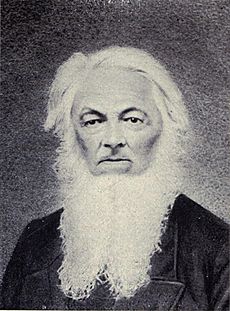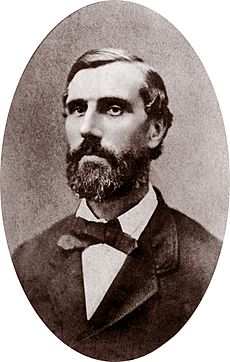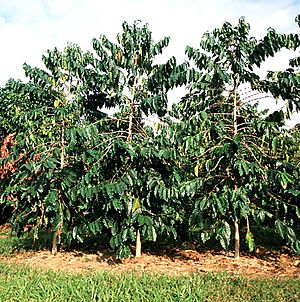Coffee production in Hawaii facts for kids
Hawaii is one of the special states in the U.S. where growing coffee is a big part of its economy. Coffee is actually the second largest crop grown there! In 2019-2020, the coffee harvest in Hawaii was worth over $102 million. About 6,900 acres of land were used to grow coffee during that time. Many groups, like the Hawaii Coffee Association and the University of Hawaii at Manoa, help support the coffee industry in Hawaii.
History of Coffee in Hawaii
The first time coffee was mentioned in Hawaii was on January 21, 1813. A man named Don Francisco de Paula y Marin wrote in his journal that he had planted coffee seedlings on the island of Oʻahu. We don't know much about what happened to those first plants.
Later, in 1825, a gardener named John Wilkinson brought more coffee plants from Brazil. He planted them in the Mānoa Valley on Oʻahu. Sadly, Wilkinson passed away, and those trees didn't grow very well. Some parts of the plants were moved to other areas around Honolulu. Other coffee plants from Manila were also grown by Richard Charlton, who was a British representative.
More coffee trees were planted in the Kalihi and Niu valleys near Honolulu around 1828 or 1829. On the island of Hawaii, a reverend named Joseph Goodrich tried growing coffee to help his mission station in Hilo become self-supporting. He taught local Hawaiians how to grow crops for money and food.
Another reverend, Samuel Ruggles, moved some coffee plants to the Kona District in July 1828. He moved from Hilo on the east side of Hawaii island to the Kealakekua Church on the west side. Even though it took time for the coffee to grow well there, this area eventually became the most successful place for coffee in Hawaii.
Early attempts to grow coffee for business on the island of Kauaʻi in 1836 and 1845 didn't work out. The first official records of coffee production were in 1845. Only 248 pounds were grown on Kauaʻi and Hawaii island. In 1848, a big change called the Great Māhele allowed people to own land privately for the first time.
Large areas on Maui used to grow coffee, but farmers later switched to sugarcane and other crops. This was partly because tiny insects called scale insects harmed many coffee trees on other islands.
The slopes in the Kona area were not good for growing sugarcane. Because of this, Kona became the main place for the coffee industry in Hawaii. For coffee to be called Kona coffee, it must be grown only in this special district.
In 1873, a big event called the world's fair in Vienna gave an award to a Kona coffee seller named Henry Nicholas Greenwell. This award helped make the "Kona" name famous. Around 1880, John Gaspar, Sr., built the first coffee mill in Hawaii near Kealakekua Bay. A new type of coffee plant, the Guatemalan variety, was brought to Hawaii in 1892 by a German farmer named Hermann A. Widemann. Around this time, ladybugs (also called ladybird beetles) helped control the scale insect problem.
When the United States took control of Hawaii in 1898, it meant that growing sugar became even more profitable. Some coffee trees were even pulled out. Coffee prices dropped in 1899 and 1900, which caused some coffee farms to close.
By 1916, Hawaii produced about 2.7 million pounds of coffee, but sugar farming continued to grow much faster. During World War I in 1917 and after a bad frost in Brazil in 1918, there was less coffee available around the world, and prices went up.
Many Japanese workers who had finished their contracts on sugarcane plantations often started small coffee farms in Kona. By 1922, most coffee production in Hawaii had stopped, except in the Kona district. In 1932, Kona had over 1,000 coffee farms. More than 90% of these were run by Japanese Hawaiians. The Great Depression in the 1930s caused coffee prices to fall, and many farmers struggled to pay their debts. After World War II and another frost in South America, prices rose again in the 1950s. Coffee production reached its highest point in 1957, with over 18 million pounds.
By the 1970s, the growing tourism industry needed more workers, so fewer people worked in coffee farming, and production went down. However, when sugar and pineapple farms closed in the 1990s, the coffee industry slowly started to grow again.
Modern Coffee Production
The main area for growing coffee in Kona is called the "coffee belt." It's about two miles wide and located at elevations from 700 feet to 2,000 feet. Other places on the island where coffee is grown include Kaʻū in the south, Puna in the southeast, and Hāmākua in the northeast.
Even though coffee can be picked all year in Hawaii, most of the coffee is harvested from August to December. In the 2008–2009 season, there were about 790 coffee farms on the island of Hawaii and 40 on other islands. On average, each acre produced about 1,400 pounds of coffee. In total, about 7,800 acres are planted with coffee across the state. More than half of this land is outside the island of Hawaii, especially on the island of Kauai. This means farms on other islands are generally bigger than those on Hawaii island.
Some old sugarcane and pineapple farms have now switched to growing coffee, like Molokaʻi coffee.
A very harmful insect called the coffee berry borer was found in Kona coffee farms in 2010. By 2020, this beetle had spread to Oʻahu, Maui, Kauaʻi, and Lānaʻi. The borer causes a lot of damage to the coffee crop, leading to less coffee being produced. Farmers also have to spend more money spraying their crops to fight the beetle, which reduces their profit.
Another problem, called Coffee leaf rust, has also been found and could affect coffee production in 2021.
See also
 In Spanish: Producción de café en Hawái para niños
In Spanish: Producción de café en Hawái para niños




